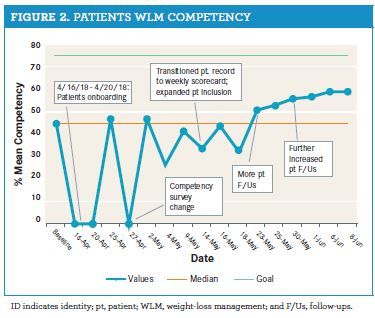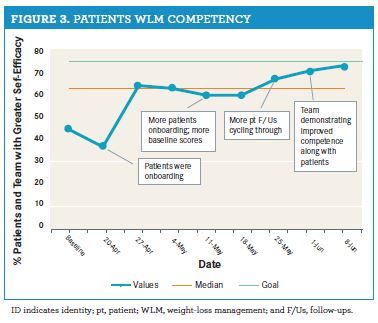Obesity Is a Weight-Loss Maintenance Problem
The prevalence of obesity has reached 39.8% of Americans, affecting 93.3 million of US adults.
The prevalence of obesity has reached 39.8% among Americans, affecting 93.3 million of US adults.1 The related consequences of the obesity epidemic are no secret either. Certain types of cancer, heart disease, stroke, and type 2 diabetes are some of the leading causes of preventable death, and their incidence is rising.2
The root of the issue, however, is not that America has a weight loss problem. Rather, we have a weight loss maintenance problem. We are really good at losing weight, but keeping it off long term is another story. Research shows that after 1 year, 98% of people who have lost weight, regain some of it, and at the 5-year mark, all of it.3 With the booming supplement and weight loss industry, fad diets, and supposed nutrition breakthroughs, what actually works? Which should patients focus on, so that implemented changes with the support of science to instill lasting change for weight loss maintenance?
A new quality improvement study4 conducted by Kevin Brunacini, DNP, APRN, implemented and tested a weight-loss-maintenance assessment that reinforced key behavioral competencies supported by individuals looking to sustain their weight loss long term. The study has major implications for all sectors of health care, as projections can help to implement changes in obesity treatment and management.
Discussion
The overall focus of this study was to assess participants’ relative strength of the MASTER behaviors to weight loss: monitoring statistics, accessing support, self-control/self-regulation, tame food choices/trigger awareness, emotional intelligence, and reflection.4 They were scored by a team of licensed and trained clinicians, from a baseline level to 1 of 5 ratings: novice, advanced beginner, competent, proficient, and expert. The aim of the study was to increase patient self-efficacy by 30% in a 90-day period.5
Using the WLM assessment correlated to a 27.5% increased likelihood of a patient maintaining their weight. Completion of the patient intake form was 100% during the study, and this served as a method to identify and quantify patient WLM behavioral risk, which ranged from 60% to 100%, with a mean of 87%. Utilization of the WLM assessment averaged 84%, and peaked at 97%, and this was also seen among the patients’ competency scores (mean, 43%; range, 0%-59%) as they advanced.
Interpretation
Both the team and patients influenced our results. After the initial onboarding process, WLM competency scores trended up as the ratio of established patients to new patients grew. The intake form was modified to better identify risk and continue collecting weekly results on the patient scorecard. Keeping the processes practical and simple carried over into patient care, which permitted for better teaching opportunities and more specific support. When the patients made lifestyle changes, it reduced the risk of regaining weight within a few years.6-8
One patient remarked, “This was a true mentorship. The honesty, time to educate, optimism, sincerity to help me. I feel better already.”
Another patient shared, “I’m impressed by the intensity of compassion to help me lose weight and understand how to keep it off.”
Open communication was critical for effective and timely teaching.9,10 Being able to stratify patient behavioral risks on intake forms allowed the clinicians to begin teaching and formulating a plan early in the process and provide patient-centered care with the WLM assessment during weekly follow-ups. Weekly competency grading also resulted in reinforcing the understanding, application, and overall competence of the WLM behaviors for both the patients and team. Throughout this project, the power of collaboration and trust was affirmed, and this is the essence of primary care.11-16 The potential role we can play as pharmacists in this process as being the most accessible health care provider is profound in helping patients make lasting changes toward optimal health.
Figure 1 (Brunacini, 2018) shows that as patients were being “graded” on their weight loss management competence, so were the clinicians’ understanding of the concepts.

Figure 2 (Brunacini, 2018) shows that initiating a baseline competency score allowed for clinicians to better use the weight loss management assessment in patient follow-ups to serve as a weekly snapshot of progress. Once patient inclusion criterion expanded, patient volume was more evenly dispersed throughout the week to consistently stratify patient behavior risk during consults and weekly follow-ups.

(Brunacini, 2018) shows that after the onboarding process was complete, another hurdle was getting patients to complete a weekly competency survey as it related to the weight loss assessment concepts. Clinicians used a weekly scorecard to grade patients during follow-ups. Based on these updated scores, the clinicians referred the patients to the weight loss management assessment as guidance to strengthen needed areas.

Adam Martin, PharmD, ACSM-CPT, is the founder of TheFitPharmacist movement, which strives to empower pharmacists and pharmacy students to thrive in their careers by overcoming stress and unhealthy habits using science-based principles and unmatched support. He also created “TheFitPharmacist” podcast on the PharmacyPodcast network. In addition, he is the owner and nutrition consultant at The Diet Doc Pittsburgh North in Pennsylvania.
References
- Hales CM, Carroll MD, Fryar CD, Ogden CL. Prevalence of obesity among adults and youth: United States, 2015—2016. NCHS Data Brief.2017;(288):1-8.
- Managing overweight and obesity in adults. National Institutes of Health website. wwwnhlbi.nih.gov/sites/default/files/media/docs/obesity-evidence-review.pdf. Published 2013. Accessed September 6, 2018.
- Befort CA, Stewart EE, Smith B, Gibson CA, Sullivan DK, Donnelly JE. Weight maintenance, behaviors, and barriers among previous participants of a university-based weight control program. Int J Obes (Lond).2008;32(3):519-526.
- The six domains of health care quality.Agency for Healthcare Research and Quality website. ahrq.gov/professionals/quality-patient-safety/talkingquality/create/sixdomains.html. Updated March 2016. Accessed September 6, 2018.
- Community connections: linking primary care patients to local resources for better management of obesity. Agency for Healthcare Research and Quality website. ahrq.gov/professionals/prevention-chronic-care/improve/community/obesity-toolkit/obtoolkit-tool3.html. Updated March 2014. Accessed September 6, 2018.
- Benner P. From novice to expert. Am J Nurs. 1982;82(3);402-407.
- Sorgente, A, Pietrabissa G, Manzoni GM, et al. Web-based interventions for weight loss or weight loss maintenance in overweight and obese people: a systematic review of systematic reviews. J Med Internet Res. 2017;19(6):e229. doi: 10.2196/jmir.6972.
- Adult obesity facts. CDC website. cdc.gov/obesity/data/adult.html. Updated August 13, 2018. Accessed September 6, 2018.
- Finkelstein EA, Khavjou OA, Thompson H, et al. Obesity and severe obesity forecasts through 2030. Am J Prev Med. 2012;42(6);563-570. doi: 10.1016/j.amepre.2011.10.026.
- Garvey WT, Mechanick JI, Brett EM, et al; Reviewers of the AACE/ACE ObesityClinicalPracticeGuidelines. American Association of Clinical Endocrinologists and American College of Endocrinology comprehensive clinical practice guidelines for medical care of patients with obesity.Endocr Pract. 2016;22(suppl 3):1-203. doi: 10.4158/EP161365.GL.
- Nutrition and weight status. HealthyPeople.gov website. healthypeople.gov/2020/topics-objectives/topic/nutrition-and-weight-status. Accessed September 6, 2018.
- Ogrinc GS, Headrick LA, Moore SM, Barton AJ, Dolansky MA, Madigosky WS. Fundamental of Health Care Improvement: A Guide to Improving Your Patients’ Care. 2nd ed. Oakbrook Terrace, IL: Institute for Healthcare Improvement and Joint Commission Resources; 2012.
- Reeves R, Biesemeier C, Gee M, Harper P, St. Jeor S. Adult weight management.Academy of Nutrition and Dieteticswebsite. andeal.org/vault/pq132.pdf. Published 2014. Accessed September 6, 2018.
- Perceived competence scales. Self-determination Theory website. selfdeterminationtheory.org/perceived-competence-scales/. Accessed September 6, 2018.
- Health-care self-determination theory questionnaire. Self-determination Theory website. selfdeterminationtheory.org/health-care-self-determination-theory/. Accessed September 6, 2018.
- Thomas JG, Wing RR. Maintenance of long-term weight loss.Med Health R I. 92(2);53, 56-57.

